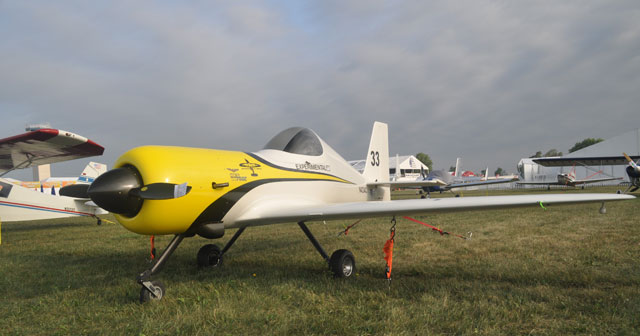
Andy Chiavetta's LT-1 Bobcat took home a "Bronze Lindy" award from EAA in the plans-built category.
Like many pilots, Andy Chiavetta flew to Oshkosh, Wis., in July to show off his experimental amateur-built aircraft. But for Chiavetta it wasn’t just for personal pride: He was looking for a market for his single-seat Aerochia LT-1 Bobcat kit.
EAA AirVenture, which draws hundreds of thousands of visitors and springs from a legacy of homebuilding, offers a venue to show off new designs and look for customers. And while bringing a certificated aircraft to market presents significant financial challenges for both manufacturer and customer, the experimental world has a lower barrier to entry for those willing to put in the man hours. Chiavetta took home a “Bronze Lindy” award from EAA in the plans-built category for his creation; at the end of the week, he summed up the LT-1’s reception with a photograph of trampled grass that had left an outline of the airplane.
 Andy Chiavetta kept the LT-1 to Dodge County Airport in Juneau, Wis., before EAA AirVenture.
Andy Chiavetta kept the LT-1 to Dodge County Airport in Juneau, Wis., before EAA AirVenture.
“The response to my plane has been far better than I could have ever thought,” he wrote. “I have had many people that I have greatly admired come over and tell me that I am on to something good. ... I hope this is only the start of all the fun.”
Chiavetta, who has built racing aircraft for the National Championship Air Races in Reno including a champion modified Lancair Legacy for Darryl Greenamyer, said he started on the carbon-fiber LT-1’s design in college.
“Basically it started from a piece of paper and a large block of foam,” he said.
Before the 2012 AirVenture fly-in, the airplane was zipping around Dodge County Regional Airport in nearby Juneau with the cowling off, running some taxi tests before heading to Oshkosh for its closeup. The LT-1 has an empty weight of 500 pounds and a 60-horsepower engine, with a useful load of 293 pounds. It carries 8 gallons of fuel per side and burns between 3.5 and 4 gallons per hour, cruising at about 125 knots, Chiavetta said. Pilots new to the aircraft might be surprised to find they need left rudder on climbout, as the propeller spins counter-clockwise. The website lists special pricing for the fly-in as $29,900 for the kit without the engine.
Chiavetta, whose aircraft modification company Aerochia generally focuses on racing modifications, said he wanted this airplane to be comparatively fast but easy to fly, and it has tricycle gear so that pilots would be able to fly it easily. “I tried to make something that’s fast, but not dangerous,” he said.


